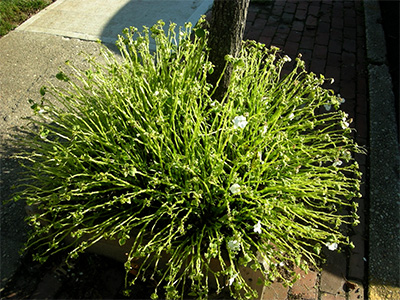
From Margery Daughtrey, Senior Extension Associate, Plant Pathology and Plant-Microbe Biology Section, School of Integrative Plant Science, Cornell University. She is based at the Long Island Horticultural Research & Extension Center, Riverhead, N.Y. Click on images for larger view.
Everyone is asking about impatiens: Is it safe to plant them again?
Beginning in 2008, a new disease, impatiens downy mildew, started showing up in the landscape in Saratoga Springs, N.Y. By 2012, it was wreaking widespread havoc all season long for gardeners in New York and many other states.
With a few exceptions, the disease only plagues the impatiens commonly used as a bedding plant in shady locations (Impatiens walleriana) and a close relative, balsam impatiens (Impatiens balsamina). But the disease can also infect native jewelweed (Impatiens capensis).
The disease is most devastating on the bedding impatiens. They stop flowering, drop all their leaves, and keel over. Balsams just show spots on their leaves with the characteristic white “downy” spore structures coating the undersides of the leaves.
Infected impatiens show characteristic white “downy” spore structure coating on the undersides of the leaves.
The dramatic outbreaks of this disease have not been as widespread in recent years. But that is because greenhouse growers and landscapers and have shied away from producing a plant that they knew wasn’t going to perform reliably. Fewer plants grown means fewer instances of the disease.
But impatiens downy mildew hasn’t gone away. In 2014, my helpful network of impatiens-watchers reported the disease in Plattsburgh, N.Y., and the Hudson Valley in June, in balsam impatiens flower beds in Lockport, N.Y., and Buffalo in July, on bedding impatiens in central New York and on Long Island in August, and in Rochester in September. The disease also turned up in 20 other states last year.

So, no. The disease is not gone. But we are using less of its host plant so we don’t hear as much about it.
Here’s the problem: Impatiens downy mildew can persist in frost-free parts of the country, and also the mildew can form special spores called oospores that we expect may help it to survive New York winters and re-infect plants the following season. Cornell researchers are focusing on the oospores to learn more about the overwinter survival of the downy mildew, and on breeding new hybrid impatiens that are less susceptible to the disease.
Ultimately, the solution to this problem will be found by breeding downy-mildew-resistant impatiens. In the meantime, gardeners can grow New Guinea impatiens and the new hybrid Bounce™ impatiens with full confidence, knowing that they will resist the downy mildew and flower colorfully all season.
And it’s perfectly OK for gardeners to add in a few bedding impatiens in shady areas, along with begonias, coleus, torenia and other great bedding plants that flourish under similar shady conditions. (Nora Catlin, Floriculture Specialist with Cornell Cooperative Extension of Suffolk County, created a great factsheet on Alternatives to Garden Impatiens.)
The luckiest of the impatiens will escape downy mildew. We just need to realize that they are still susceptible to the disease, and that the disease is still a possibility, subject to the variation in weather from year to year.
For more information on impatiens downy mildew, visit the CCE Suffolk County floriculture website.



Hi. I’m telling my customers 3-6 years to plant again. Is this true?
Margery Daugherty replies:
It might be true, but then again it might not! The sunflower downy mildew lasts in the soil for 10 years. This downy mildew is cousin to that one, but there’s no way to know yet how long it will last in the soil. Waiting for the pathogen to die out will not be as good a solution as developing disease-resistant plants, or using different species that are naturally non-susceptible—like the New Guinea impatiens. In the meantime, go ahead and plant some of the bedding plant impatiens—it’s a little daring, but it’s good to be adventurous in your gardening. It’s prudent to use them mixed in with other garden flowers, though, rather than planting large masses of impatiens…the downy mildew might happen to find them.